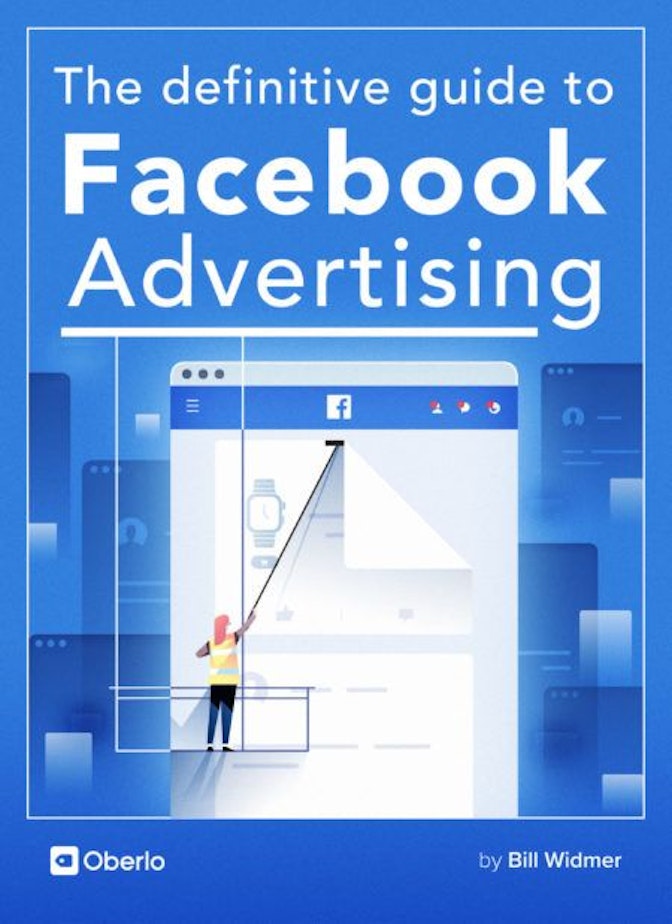You’ve got your offer. You’ve set your goals. You have an audience. You know how to create a Facebook ad.
But your ads just don’t seem to be converting. What’s the problem?
Chances are, if your target audience was selected well, they simply don’t care about your offer. Either it’s a product they’re not interested in or a deal that’s not enticing enough.
How do you know?
In this chapter, you’ll learn about Facebook ad optimization. We’ll cover:
- Facebook’s Analytics Reports
- Ad creatives
- Ad frequency
- Facebook Split Testing (AKA Facebook Creative Testing)
- Localization
- Seasonality
- Text in ads
Let’s dive in!



Facebook’s Analytics Reports
Before you start optimizing your Facebook ads, you have to know which ads you need to optimize. (Unless you’re only running one ad – in which case, you should be creating more to split test. But more on that later in this chapter.)
Now, in Chapter 2 you learned how to navigate your Ads Manager menu and visit your analytics tool to see your Facebook reports.
→ Click Here to Launch Your Online Business with Shopify
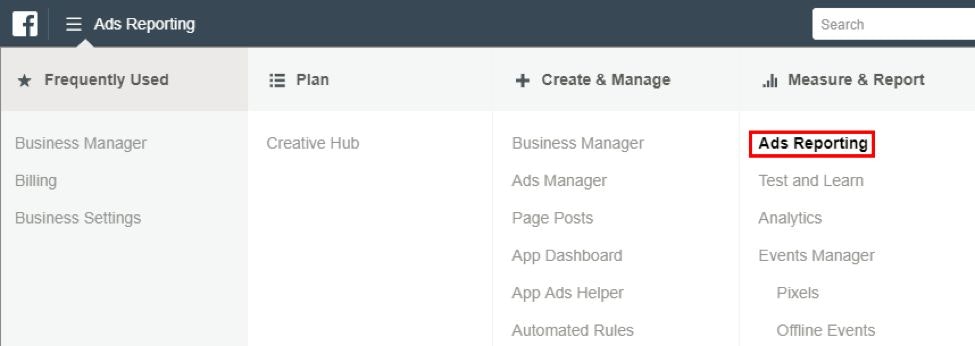
Here you’ll see an overview of any ads reports you’ve created, with details on impressions, conversions, CPC, and more. If you haven’t created any reports yet, this page will be blank.
To get started, click the blue ‘Create Report’ button. Here you can filter your ads data by objective, buying type, placement, # of impressions, and more.

You can also change which columns to display, break down the data by day, week, month, etc., and choose which level (account, campaigns, ad sets, or ads) to show. There’s a lot to play around with.
For your first Facebook reports, let’s keep it simple. We’ll identify the campaigns that are costing you too much money per acquisition.
Simply add a filter for CPA > $1 (or whatever your max CPA is). The CPA filter is under the ‘Metrics’ tab.
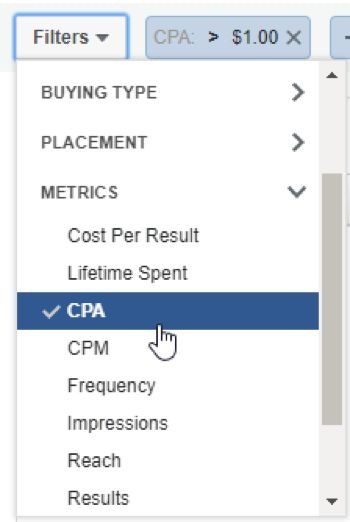
Now you’ll see which Facebook ads have a high CPA. These ads are costing you money, so you should work on optimizing or removing them first.
You can also filter by CPC or raw # of conversions if filtering by CPA isn’t helpful.
Now that you know which ads are underperforming, let’s look at your ad creative.
How to Craft Click-Worthy Ad Creative
Let’s face it: words matter.
Good advertising is about copywriting. Just ask copywriting legend Joe Sugarman – he was able to sell over 100,000 pairs of blue light blocking glasses in less than 6 months with nothing more than a newspaper ad. Did I mention these sunglasses cost $300 a pair?
That’s right – $30 million in 6 months selling glasses. Not too shabby!
So how can you follow in Joe’s footsteps? Here are a few tips:
1. Write using your audience’s language.
Harry Potter nerds use words like ‘Expecto Patronum’ and ‘Avada Kedavra’. (Yes, those are Harry Potter spells.)
But beyond literally using a fan bases unique language, you can also talk using the wording people use to describe their pains, hopes, and dreams. Let me give you an example:
Let’s say you’re selling a wireless parking sensor. You’re advertising to the right group and you need to know what to say. So you start scouting forums your audience might visit, and you come across this post:
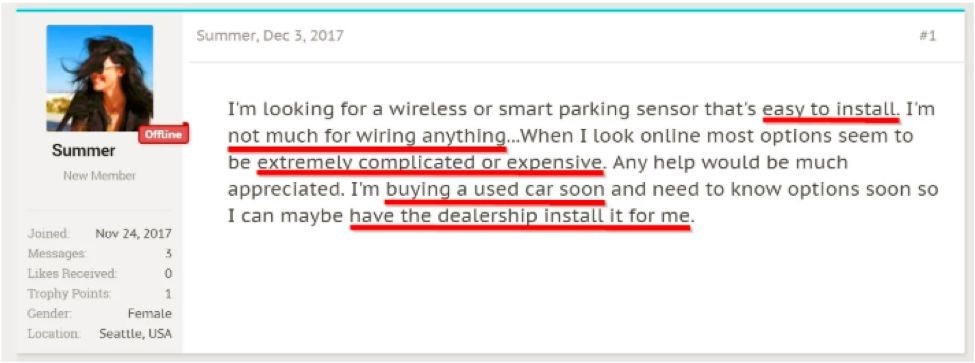
Now you know your user’s language. They want something that’s ‘easy to install’, they’re ‘not much for wiring anything’, and they don’t want anything ‘extremely complicated or expensive’.
You can translate this to your Facebook advertising creative. Your ad headline might be something like “Finally! A Wireless Parking Sensor That’s Easy to Install!” or “Not much for wiring anything? These wireless parking sensors are ridiculously easy to install”.
See how you can use your audience’s language? It’s like you’re speaking directly to them.
To figure out how they word things and the phrases they use, you can do a Google search for forums around your product/niche or prowl some Facebook groups you’ll be targeting. It’s easy to do, but also easy not to do – so don’t skip this step!
2. Run different ads for different audiences.
I hope you’re starting to notice a trend – Facebook ads are successful because of their ability to hyper-target the right people.
They aren’t like billboards or TV ads where you need to appeal to a broad group of people. You can make the perfect ad that speaks directly to your target audience.
And you should go even further to hyper-target segments within your audience.
For example, there are Harry Potter fans. But then there are people who specifically love Gryffindor, or Slytherin, or Hufflepuff or Ravenclaw. Each will have their own language, pains, wants, and dreams.
There are golfers. But then there are competitive golfers, casual golfers, and amateurs who only play a few times a year.
There are beer drinkers. But then there are people who love IPAs (or even specific IPAs), people who will drink anything that’s cold on tap, people who like light beer, people who like specific brands, etc.
You get my point. The more specific you can be, the better your ads will convert. The better you know that specific customer, the better your ads will convert. Run multiple hyper-focused ads rather than one blanketed ad.
3. Make sure your ad copy matches your image.
Sometimes an image is just slapped on and the focus is on the copy. But when that happens, it’s easy for the visual to not make sense with the text.
Always make sure the image matches the text. It’s a simple step, but an often overlooked one.
I recommend getting a second pair of eyes on your Facebook ads formula – someone who doesn’t work with the company or at least doesn’t work on the ads – to get an outside opinion. Sometimes it’s hard to see the most obvious things when your head is down on the grindstone.
4. Keep it short and show value first.
People don’t care about the features of a product. They care about the benefit – what’s in it for them?
This goes back to doing proper market research. You need to know what your customers really care about so you can lead with their desire (or pain point).
- Are they frugal? Lead with how much money they’ll save.
- Are they trying to lose weight but struggling? Lead with how 500 people already lost weight with your product.
- Do they absolutely hate doing dishes after cooking dinner? Lead with how your frozen dinners don’t require dishes and even come with pre-packaged plastic utensils.
I’m pulling examples out of nowhere here, but I hope you get my point. Lead with the deep desires or solutions to pain points of your target market.
5. Follow KISS: Keep It Super Simple.
A great writer (and copywriter) is not the one who knows the fanciest, most complex words. It’s the person who can take fancy, complex jargon and break it down into its simplest terms.
In the words of Leonardo Da Vinci:
“Simplicity is the ultimate sophistication.”
Write your ad so even a 5th grader could understand it. When someone sees your ad, they should immediately know:
- What you’re offering
- How it benefits them
- What to do next
Let’s look at SoFi’s ad, for example.
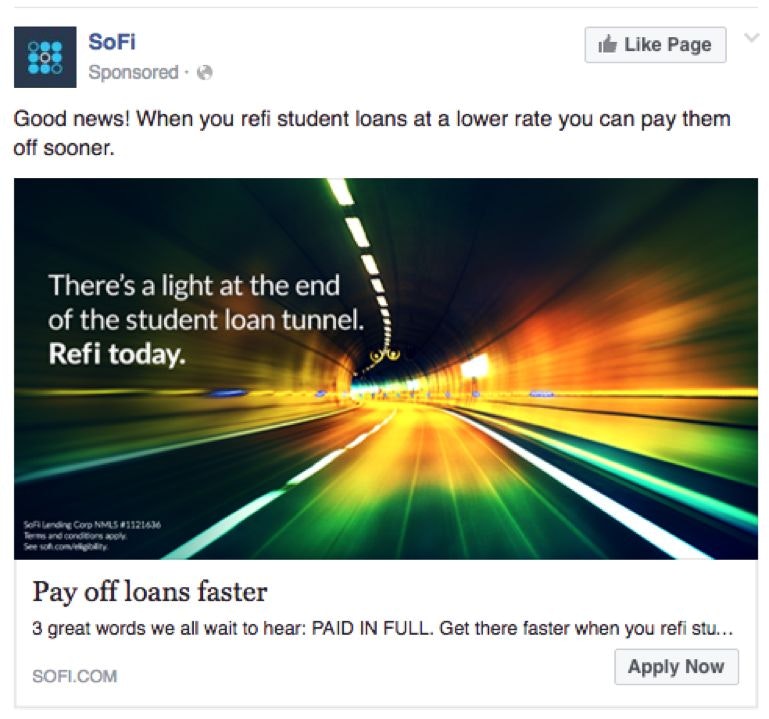
While the image could do a bit better of a job (it’s kind of a stretch), the copy is spot-on. You immediately know what the benefit is: pay off loans faster. What student doesn’t want that?
They even have ‘PAID IN FULL’ in caps. It helps you imagine that sweet, sweet feeling of being debt-free, which entices you to click. Nice and simple.
6. Don’t hide the price.
There’s nothing that pisses people off more than clicking on an ad expecting one price, only to see a higher price when the page loads.
Plus, leading with the exact prices helps build trust and shows transparency, which leads to higher conversions for the people who do click.
Car companies do this well. Take a look at this ad from Ball Honda:
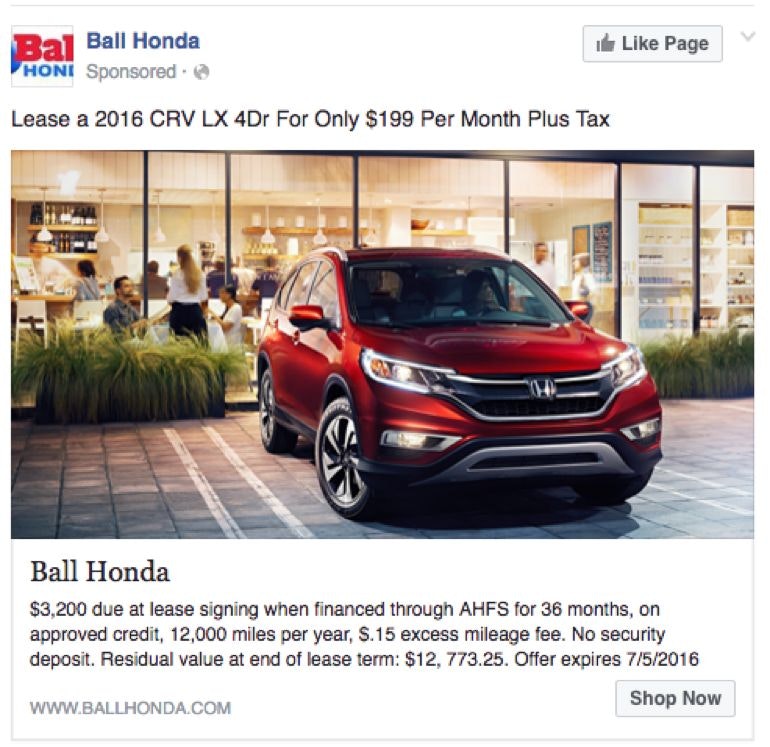
They tell you the exact monthly cost, up front deposit, loan length, and more. They even tell you the residual value at the end of your lease term! Now that’s transparency!
If you’re doing this for eCommerce, a way to do this is to say things like ‘$X (Tax not included)’ or ‘$X plus shipping’. No hidden fees!
Note: Expensive fees are actually the #1 reason people abandon their shopping cart. So the more open you can be about fees, the fewer people will abandon ship!
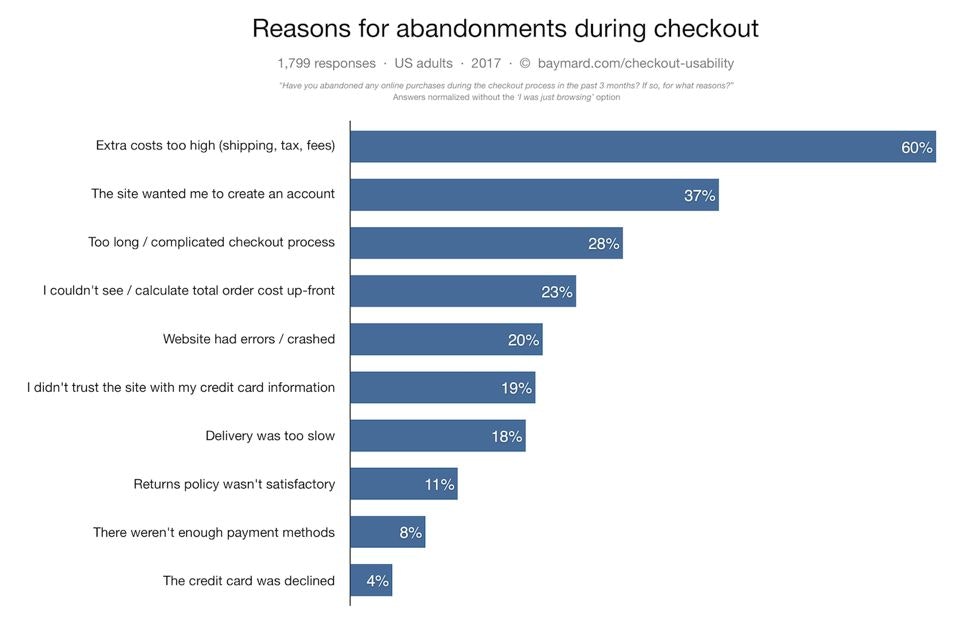
7. Spy on the competition.
If all else fails, look at your competitor’s ads. What benefits are they highlighting? What offers are they promoting? What’s their sales copy and ad creative?
You can borrow from their ads to improve your own.
To see competitors’ ads, you have a few options:
There are other Facebook advertising spying tools as well if you search around. Just find something you like that’s in your budget and go with it.
If you notice your competitors are all using specific wording or offers, try them out for yourself. It could be the key to higher conversions!
But enough about optimizing your ads. There’s something else you need to learn about to avoid burning out your audience or spending too much: Ad Frequency.
All About Facebook Ad Frequency
Ad frequency refers to Facebook’s method of tracking how many times a display ad was shown to the same person.
You can calculate it by dividing the number of impressions delivered by an ad by the number of unique visitors reached by an ad. The frequency of an ad is also influenced by the budget of your acccount as well as your target audience (e.g. their interests and behavior).
Ad Frequency = Impressions ÷ Reach
Frequency of an ad important because it’s the only metric that tells you why you may have reached (or failed to reach) a certain performance level. Other metrics, like CPC, impressions, clicks, etc., only tell you how it’s performing, not why.
It is also important because it can help you avoid ad fatigue and banner blindness.
- Ad Fatigue refers to people getting sick of seeing the same ad over and over again, to the point where they stop clicking on it. Your Facebook ad frequency will continue to go up while your CTR goes down.
- Banner Blindness is when your ad looks too much like a banner ad and, since people have been overexposed to banner ads, they tend to ignore them. A high frequency and low CTR can also mean your ad is suffering from banner blindness.
So how can you tell? If your CTR starts out high but drops as frequency increases, you’re probably experiencing ad fatigue. If your CTR is low to start and continues to be low even after increased frequency, you’re probably suffering from banner blindness.
A good ad frequency is typically around 1 to 2.
Anything under a 1 suggests your ads are too spread out and aren’t reaching your target audience. A frequency that’s above 4 in the news feed (or 8 in the right column) means you’d typically start to experience ad fatigue and banner blindness.
You can put a cap on your ad frequency by capping your CPC bidding. If your bidding is lower, Facebook won’t be able to show it to people as often, since to do so would increase the CPC beyond your threshold.
Note: Keep in mind that if your audience is very small, you are likely to see much higher ad frequencies (since there aren’t as many people to show the ad to).
How to Combat Facebook Ad Fatigue and Banner Blindness
If you do start to experience ad fatigue and/or banner blindness, it simply means you need to start switching up your ads. A new image is usually enough to keep things fresh, so start there.
Ideally you’ll want to rotate your ads as soon as you start to see a dip in efficiency.
Some experts say to rotate your ads weekly or every two weeks, others suggest every three days. Others say to have two or three ads revolving constantly. But every business is unique, and you’ll have to find the best timing for yourself.
The Takeaway: Change your ad when your frequency increases and your CTR decreases.
The easiest way to know when to rotate an ad is to watch your response graph of clicks and actions in your analytics. When you see these metrics start to dip, rotate.
Eventually, however, you may need to present a new offer altogether. You’ll know when that happens if you continue to see low CTR and conversions despite changing the image and/or text several times.
Now that you understand ad frequency, let’s talk about one of the most important aspects of Facebook advertising: Split Testing!
Facebook Split Testing
Split testing (or A/B testing) is displaying two or more near-identical ads at the same time, but changing one variable (such as the copy, image, headline, etc.) to see which performs best.
Here’s a visual explanation:
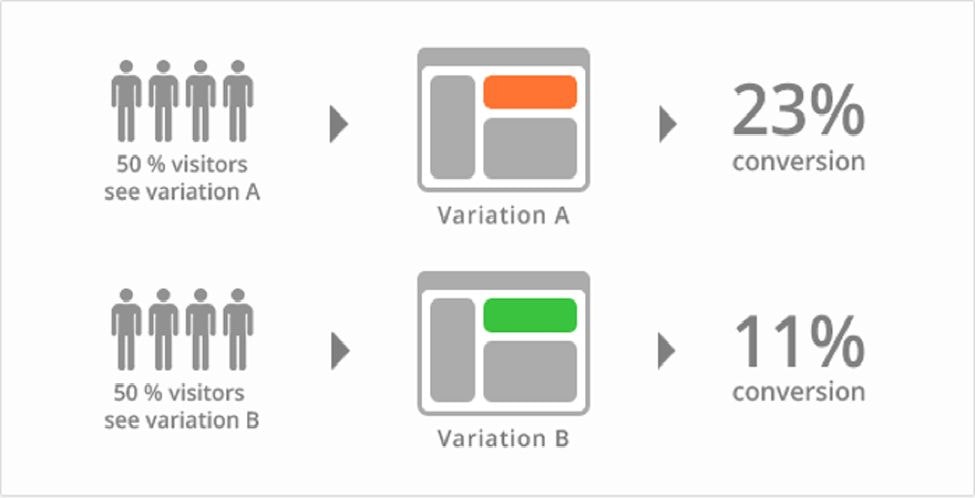
You show half of your audience one variation of the ad, and the other half another variation, in order to see which variation converts better. It’s important to only test one element at a time, or else you won’t know which change caused the increase.
Let’s dive into the how-to!
How to Split Test Your Facebook Ads
Facebook has a built-in split testing tool to easily test your ad creative. It’s super easy to use, here’s how:
- Create a new ad campaign just as you normally would.
- Check off the ‘Create Split Test’ box on the ad objective page.
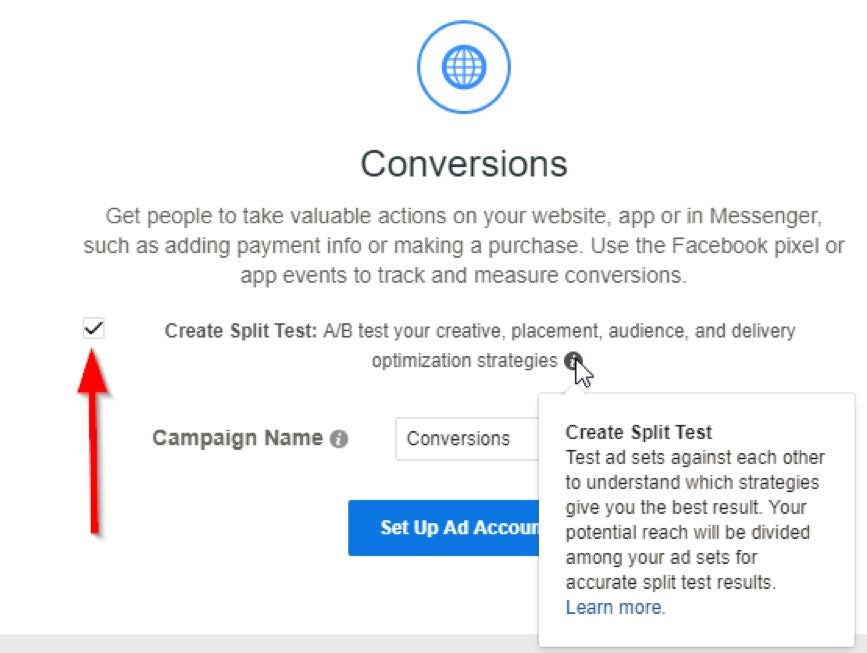
- While choosing your Ad Set settings, you’ll notice a box titled Variable. Here you can choose exactly what to test: Creative, Delivery Optimization, Audience, or Placement
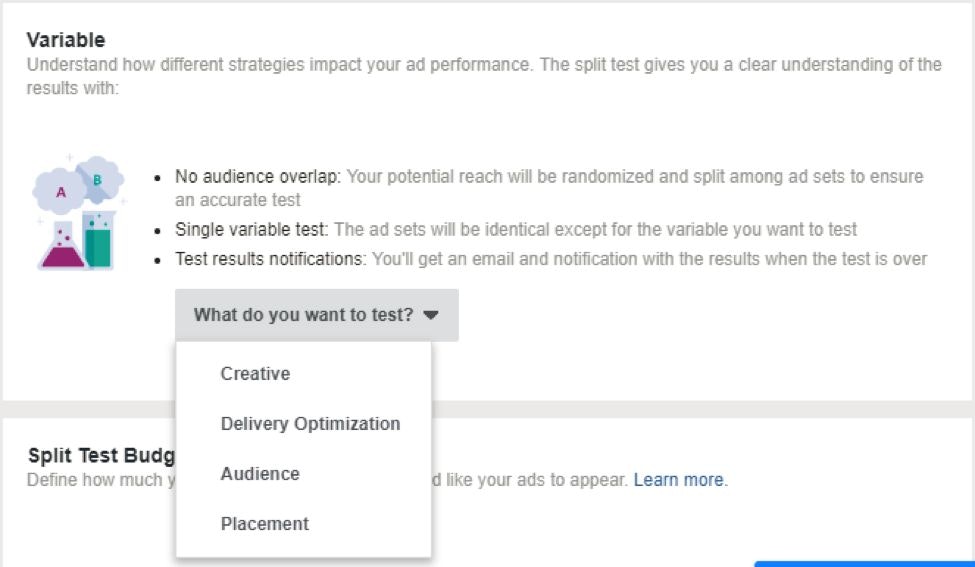
- These tests are organized by creating an ad set for each ad variable, NOT by creating multiple ads under the same ad set.
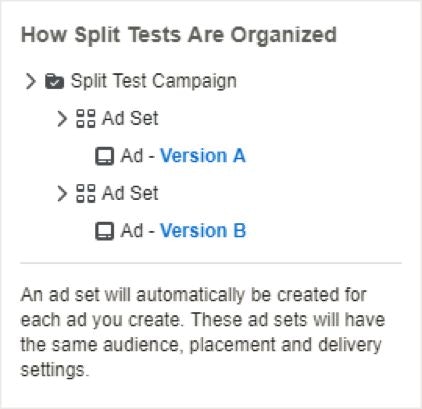
- Once you’ve set up the ad, you need to set up your test budget. By default, your total budget is split evenly between all your ads. However, if you select the drop-down, you can choose a ‘weighted split’ option, which allows you to set certain percentages to different ads.
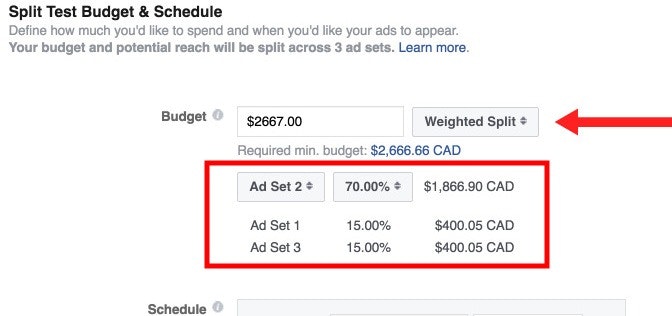
And that’s all there is to split testing your Facebook advertising! Now you just let them run and see which performs the best, then scale that version up with a higher budget. Or better yet, continue running creative tests to continue to optimize your ad.
Note: Your split test needs to run for at least 3 to 14 days in order to be conclusive, depending on your budget. However, there is an option to end the split test early once a winner has been found, so you can always set it to 14 days and turn this on.
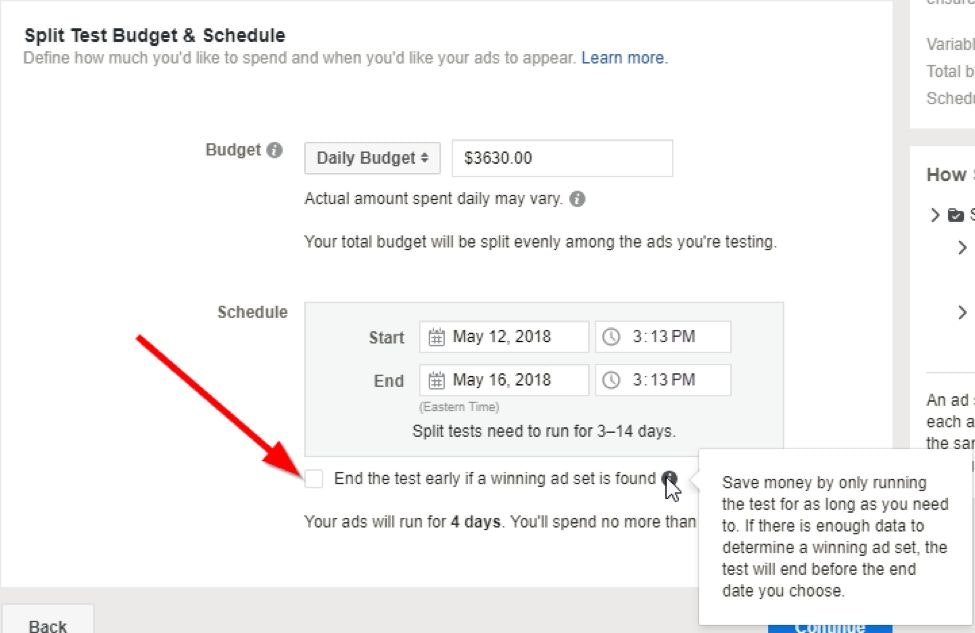
Now let’s talk about how to maximize your split tests.
The Ultimate Facebook Creative Testing Strategy
For this section I’ll hand the mic off to Azriel Ratz of Ratz Media, a Facebook ad expert who’s spent over $1 million testing Facebook ads.
Ratz recommends you create three sentence variations for your ads:
- Sentence A in the Text Post
- Sentence B in the Headline
- Sentence C in the Description
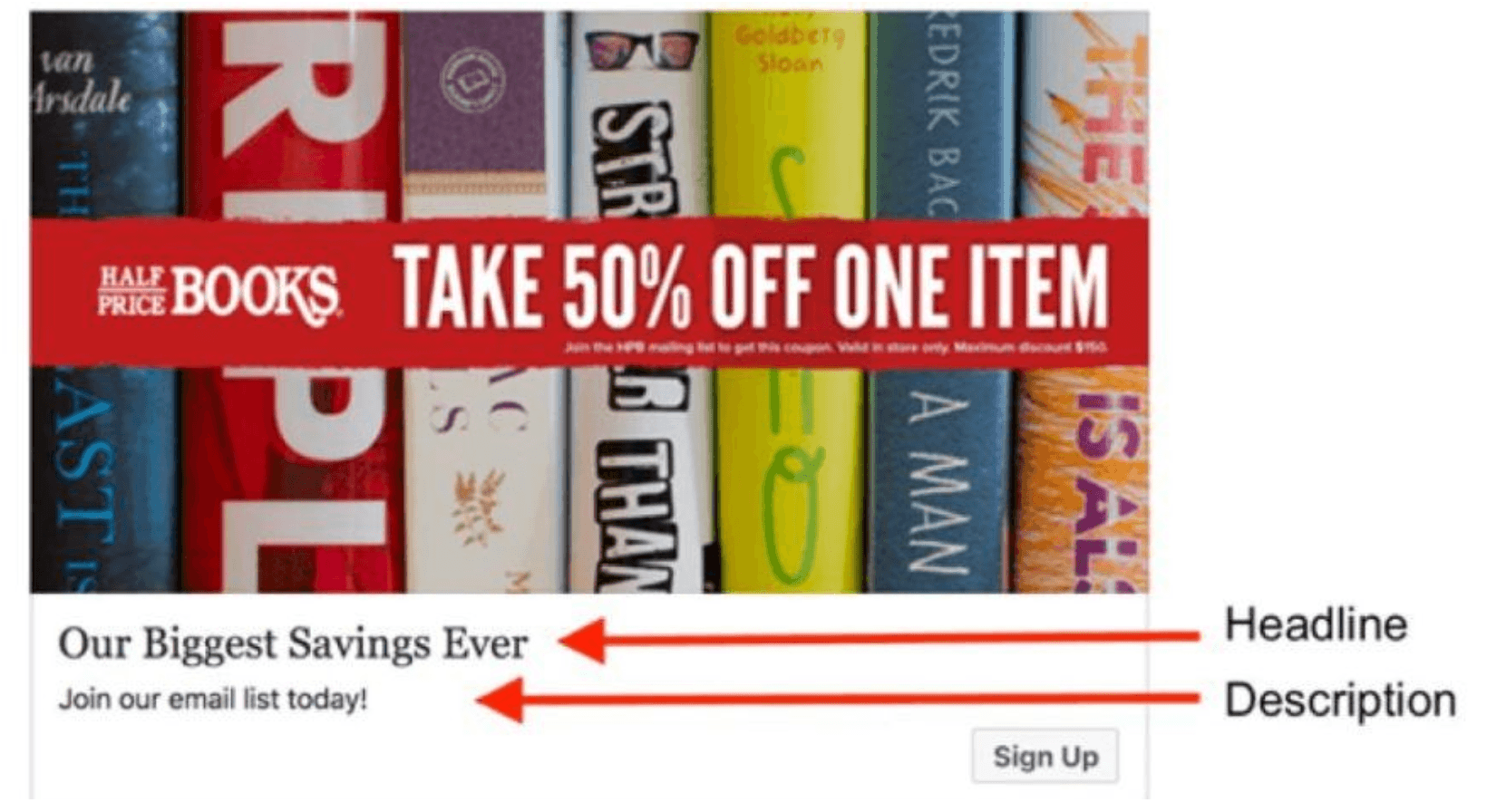
From here, he recommends you create your ads like you normally would (select the image or video and duplicate them), but switch the placement of two of the sentences. Duplicate this process until you have every possible combination (6 in total).
It looks like this:
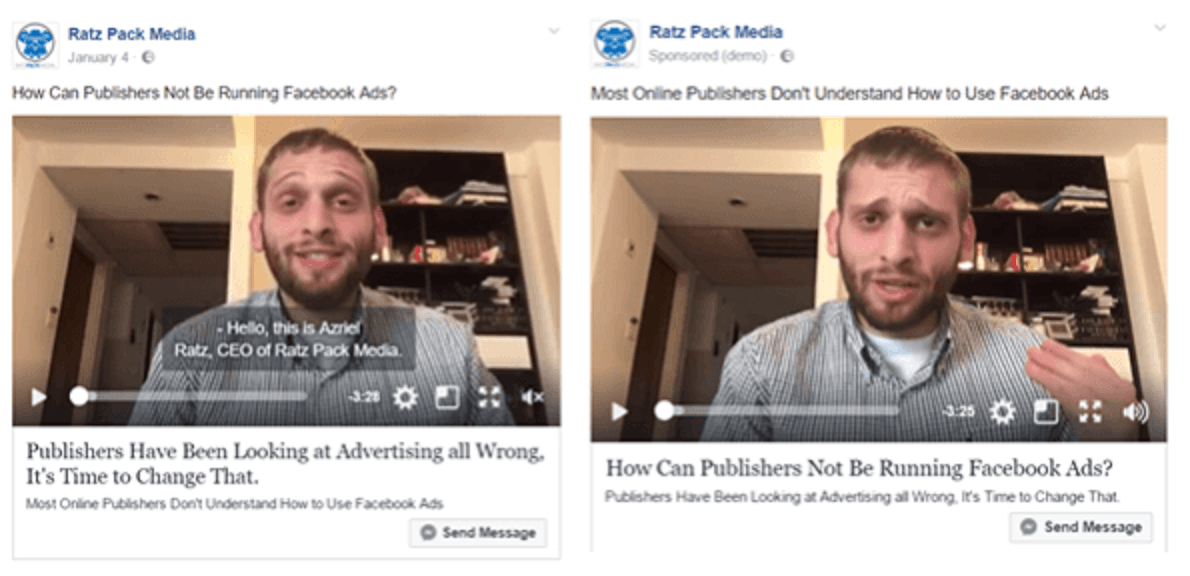
Next, duplicate all six of those ads and use a different image/video (or video thumbnail) for each variation. Ratz recommends trying at least four image variations.
Finally, repeat that process with three different sentences (D, E, and F) to create a grand total of 48 ad variations!
Note: Facebook only allows 50 ad variations per ad set, which is why he recommends the exact numbers or variations above.
If you really want to dive in, you can also create 5-10 additional ad sets, each with the 48 ad variations, each targeting a different audience. Pretty cool, right?
Two quick tips:
- Allow your ad variations to run for at least 48 hours before you compare them. Anything less than that isn’t giving Facebook enough time to show your ad to the audience.
- Add UTM parameters to each ad set so you know which audience is performing the best and it’s easier to compare their time on site.
Once you’ve let them run for two days, here’s what you should compare:
First, look at Facebook CPM (Cost Per Impression). A higher CPM for a particular ad set means either 1) the ad is good, but it doesn’t appeal to the targeted audience or 2) you’re targeting a good audience, but the ad is bad.
In the first case, you need to test new audiences. In the second case, you need to create different ad offers.
Next up, look at CPC (Cost Per Click). If your CPC is too high, you need to create more compelling ads. Your audience and offer are good, but you’re not being aggressive enough getting them to click.
In this case, you should create a more assertive CTA (Call to Action), such as literally saying ‘Click here’ or telling them explicitly what they need to do.
After that, look at time on site. This is where those UTM parameters come in handy, as you can’t see this data on Facebook analytics. Head over to your Google Analytics account and compare those UTM parameters time on page.
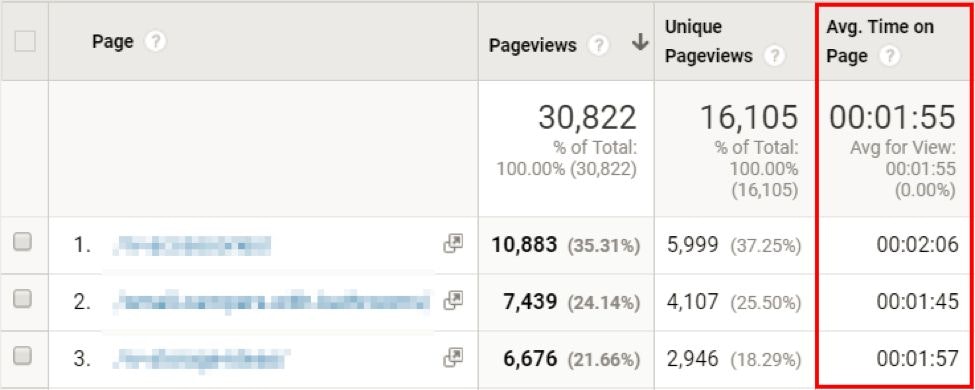
To do this, go to ‘Behavior’ in the left-hand menu, then click ‘Site Content’ -> ‘All Pages’. Then click ‘advanced’ next to the search bar and type in the UTM campaign name you created.

If your ad gets a lot of clicks, but has a very low time on page (like 10 seconds, for example), something is wrong. According to Ratz, this could mean:
- You’re spending too much on Audience Network.
- You’re targeting the wrong audience.
- The ad and the landing page have a message mis-match.
The solution here is to make sure your landing page matches the ad you’re showing. For example, if the ad says ‘Half price books’, the first thing people should see when they click the ad is big bold letters saying ‘Half price books’.
Pro tip: If you’re sending traffic to a product page, be sure to have epic product descriptions!
You should also look at desktop versus mobile visitors to see if there’s a difference here. Your mobile landing page may be broken or not user-friendly.
To see desktop vs. mobile on Google Analytics, add a secondary dimension of ‘Device Category’. Click the secondary dimension dropdown and type in ‘device’ to find it.
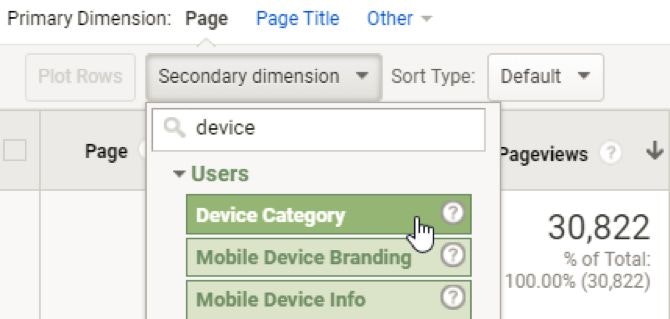
Finally, we want to look at your ads’ conversion rates. It’s possible that you’re targeting the right people with a great ad and you’re getting loads of clicks and a high time on page, but still aren’t getting people to buy.
In this situation, here’s what Azriel Ratz recommends:
- The audience doesn’t like this offer, so offer something else.
- You’re asking for too much information. Stick to three or four fields max.
- You’re asking for information they don’t want to share.
And that’s all there is to it! If you’ve followed along, you’ve now performed a solid Facebook ad split test. Give yourself a big pat on the back!
But there’s more to learn, young padawan. We haven’t talked about localization yet!
Facebook Localization And You: Targeting Other Countries
Facebook advertising and split testing is easy enough when your audience is all in one country. But what if you have an international audience who speak different languages?
That’s where Facebook’s Dynamic Language Optimization tool and localization come in.
What is Dynamic Language Optimization?
Dynamic Language Optimization makes it super easy for Facebook to serve your ads to international audiences in multiple languages without manually creating separate ads and ad sets.
This is great in two situations:
- Advertising to one country that’s dominated by two or more languages.
- Advertising to multiple countries at the same time.
However, there are a few restrictions on this tool. Namely:
- Only Facebook News Feed (desktop and mobile), Instagram, and Audience Network are currently eligible.
- You can only have up to six languages.
- You’re restricted to certain objectives.
- Only one image can be applied to all variations, and text in the image won’t be translated.
Disclaimer: Keep in mind that although this tool is extremely helpful and saves a lot of time, you still need a translator or a way to translate your text accurately. If you don’t have that, you may not want to dive into this yet. You also want to keep in mind that people might comment in the language you’re advertising in, and you’ll need to comment back in the same language!
New, let’s set one up!
How to Set Up Dynamic Language Optimization
Create an ad as you normally would. But this time, choose multiple languages to display your ad in on the ad creation page.
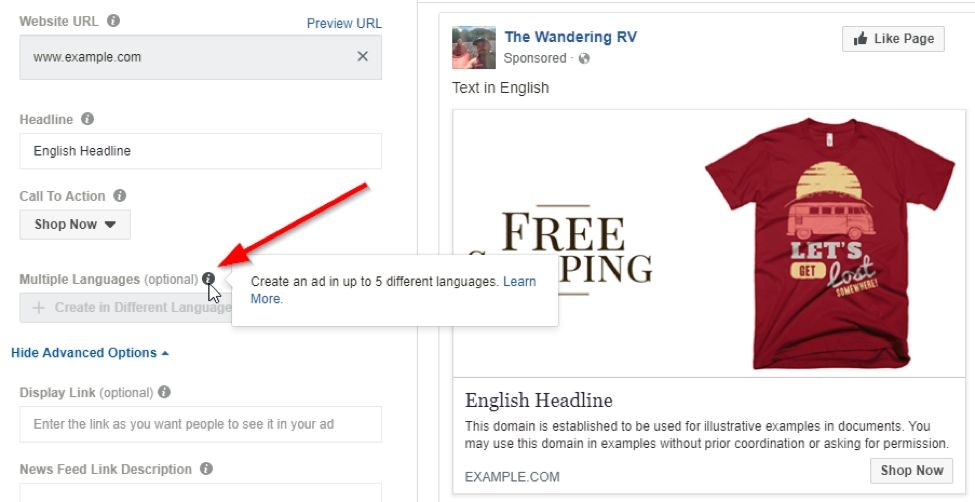
As mentioned before, this feature is only available for certain ad placements.
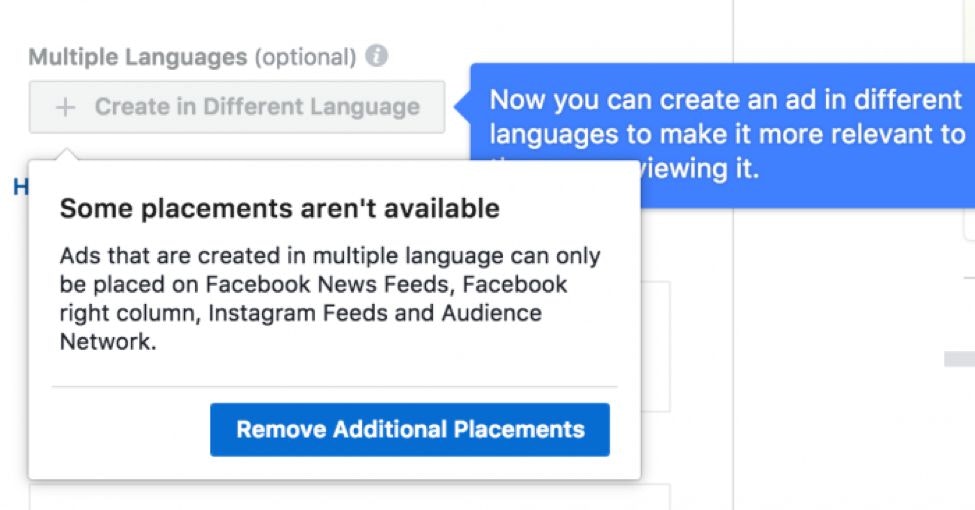
Once you click ‘Remove Additional Placements’, you can submit your separate language in these locations:
- Website URL
- Headline
- Text
- News Feed Link Description
Then let ‘er rip!
To view the results of your campaign, simply go to your Ads Reporting tool and break down the results by Dynamic Creative Asset -> Text.
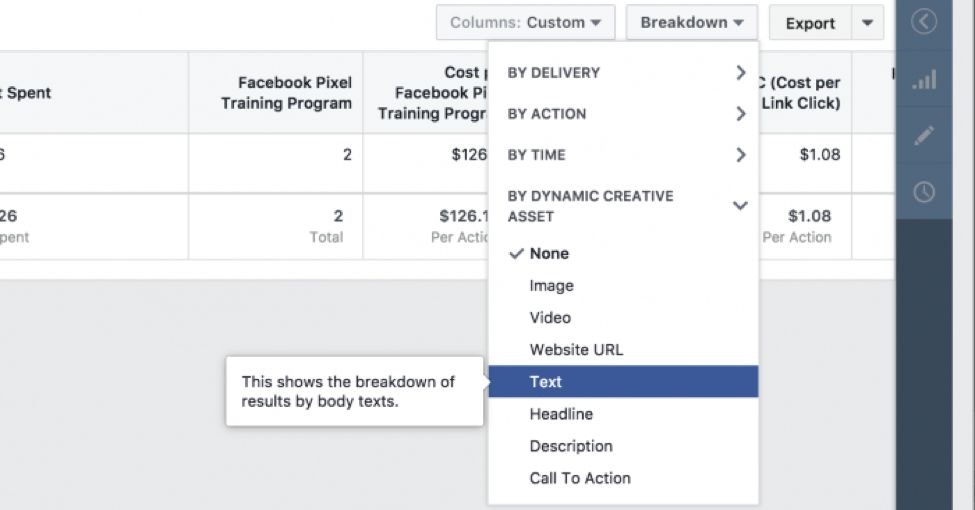
This is a tough strategy to master, but this is a complete guide to Facebook advertising, so I wanted to mention it!
You’re almost through the chapter. Two more things to discuss: seasonality and text in your ads.
How Seasonality Affects Your Advertising
If you suddenly see a dip in your impressions or an increase in your CPC and you can’t seem to figure out what’s causing it, it could be due to seasonality.
As mentioned in Chapter 2, the time of year affects the costs of your ads. It can also affect conversion rates and CTR. This is because some things people simply aren’t buying at certain times of the year.
There’s the obvious examples, like holiday decorations and Christmas gifts. But seasonality can affect other industries as well.
For example, I run an RV blog that teaches people how to live in an RV and gives travel tips. We’ve been running it for about two years now, and sure enough, our traffic always dips in the winter months. Obviously, people aren’t thinking about RVing in the snow!
If you’re unsure of the seasonal trends around your product offerings, a simple check on Google Trends can tell you. Just type in the name of the product or the niche you blog about, and Google will tell you the average search volume over the last few years for that keyword.
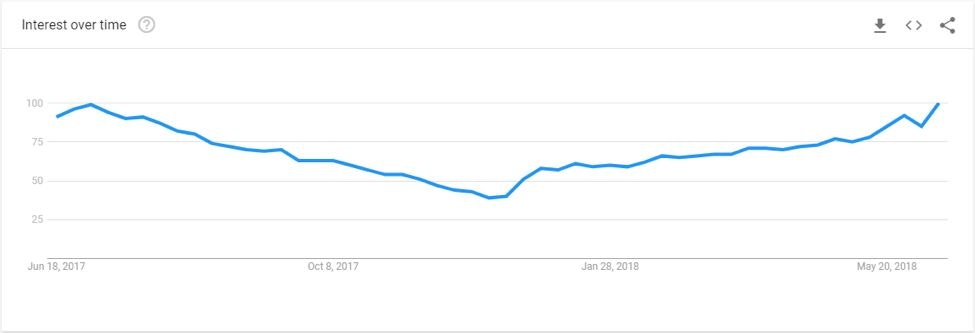
Here we can see the term ‘RV’ is most searched for from May through September, with a dip after that – this correlates perfectly with what I’ve seen over the last two years.
This doesn’t mean you can’t run ads in the off-months. In fact, the CPC may even go down in the off months, since people aren’t buying ads during that time. (On the same token, it could go up because people are still buying ads but they’re shown to fewer buyers. That’s why it’s important to test for yourself!)
The Takeaway: Use Google Trends to see if your products or niche has seasonality. Then, test your ads during those times to see if you’re still able to make money or if you should shut off ads during that time.
Keep in mind that even if you’re breaking even or losing a bit, it may still be worth running the ads just to stay top of mind. That way, when your hot season comes around, people have already been exposed to your brand for the last few months!



Wrapping Up Optimization
You’ve made it to the end of Chapter 5 – congratulations!
By now you understand how to create a Facebook ad campaign, split test that campaign, and optimize it for the best possible CVR and the lowest CPA. That’s a massive accomplishment!
Now, let’s take a look at some Facebook Advertising FAQs.

